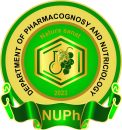1. Definition of the terms Saponins/ Cardiac glycosides.
2. Classification of saponins/ cardiac glycosides with examples of structures.
3. Chemical tests for saponins/ cardiac glycosides (name of the test, reagents used, result of the test).
4. Describe the physical and chemical properties of saponins/ cardiac glycosides.
5. Quantitative determination of saponins/ cardiac glycosides.
6. Effect of different types of hydrolysis on cardiac glycosides.
7. Correlation between the chemical structure and biological activity of saponins/ cardiac glycosides with examples.
8. Which radical in the steroidal nucleus causes the effect of “cumulation” in cardiac glycosides?
9. General types of biological activity typical for saponins/ cardiac glycosides with examples of plants.
10. Difference between the Purple and Grecian Foxglove in morphology and constituents
Microscopical description:
1. Licorice root: 1 – multilayer cork; 2 – medullar rays; 3 – crystals in parenchymal cells; 4 – bast fibers; 5 – functioning bast; 6 – cambium; 7 – vessels.
2. Horsetail herb: 1 – epidermal cells on the ribs; 2 – epidermal cells in the furrows; 3 – stomata.
3. Java tea leaf: 1 – lower epiderm; 2 – upper epiderm; 3 – stomata; 4 – simple hairs; 5 – glandular hairs; 6 – essential oil glands.
4. Purple foxglove leaf: 1 – epidermal cell; 2 – stomata; 3 – simple hairs; 4 – glandular hair.
5. Big-flowered foxglove leaf: 1 – upper epiderm; 2 – lower epiderm; 3 – stomata; 4 – large simple hairs; 5 – glandular hairs.
5. Grecian foxglove leaf: 1 – upper epiderm; 2 – lower epiderm; 3 – glandular hairs; 4 – simple hair; 5 – stomata; 6 – rosette with folded cuticle.
6. Lily-of-the-valley leaf: 1 – upper epiderm; 2 – lower epiderm; 3 – stomata; 4 – mesophyll cells; 5 – spongeous tissue; 6 – raphides; 7 – stiloids.
7. Grey wallflower herb: 1 – upper epiderm; 2 – lower epiderm; 3 – stomata; 4 – simple multiended hairs.


